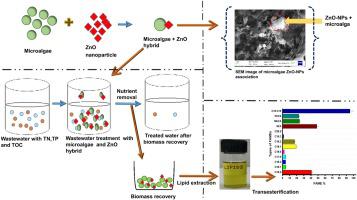Journal of Water Process Engineering ( IF 7 ) Pub Date : 2020-10-17 , DOI: 10.1016/j.jwpe.2020.101711 Shrasti Vasistha , Anwesha Khanra , Monika Prakash Rai

|
Present investigation highlighted the capability of microalgae cultivation in sewage wastewater integrated with nanomaterial, addressing wastewater treatment and consequent improvement in lipid for biodiesel application. Herein, the isolated microalga Chlorosarcinopsis sp. MAS04, was cultured in primary treated wastewater (PTWW) and secondary treated wastewater (STWW) incorporated with Zinc Oxide nanoparticles (ZnO- NPs). The characterizations of ZnO-NPs were performed by analytical technique and cytotoxicity assay of microalga against nanoparticles (NPs) was carried out prior to the experiment. The nutrient reduction rate of Chemical Oxygen Demand (COD), Total Nitrogen (TN), Total Phosphorous (TP), and Total Organic Carbon (TOC) by microalga was found higher in PTWW as compared to the STWW when incorporated with the ZnO-NPs. Maximum biomass of 3.43 g/L and 2.14 g/L along with 1.9 and 1.5 folds increase in cellular lipid was recorded in the presence of PTWW and STWW respectively as compared to control (BG-11). The cellular lipids were converted to fatty acid methyl esters (FAMEs) by the process of transesterification and analyzed by Gas Chromatography-Mass Spectrometry (GC–MS). The cells developed in PTWW and STWW incorporated with ZnO-NPs were recorded with a higher amount of saturated fatty acids (SFA) and monounsaturated fatty acids (MUFA) with controlled polyunsaturated fatty acids (PUFA). Biofuel properties were found in accordance with American and European guidelines. The present report suggested that the Chlorosarcinopsis sp. MAS04 -ZnO NPs association is capable of better nutrient removal from sewage wastewater. Therefore, the nano-bio hybrid opens a new paradigm for efficient wastewater treatment and consequent quality biodiesel production.
中文翻译:

微藻-ZnO纳米颗粒缔合对污水中有效营养去除和生物柴油应用的影响:一种综合方法
目前的研究强调了微藻在与纳米材料集成的污水中的微藻培养能力,解决了污水处理问题,并因此改善了生物柴油应用中的脂质。在这里,分离的微藻藻蓝藻sp。MAS04在掺有氧化锌纳米颗粒(ZnO-NPs)的一级处理废水(PTWW)和二级处理废水(STWW)中进行培养。ZnO-NPs的表征是通过分析技术进行的,在实验之前进行了微藻对纳米颗粒(NPs)的细胞毒性测定。与ZnO-NP结合使用时,与STWW相比,微藻中的微藻对化学需氧量(COD),总氮(TN),总磷(TP)和总有机碳(TOC)的养分减少率更高。与对照组(BG-11)相比,在PTWW和STWW的存在下,分别记录到最大生物量为3.43 g / L和2.14 g / L,以及细胞脂质增加了1.9倍和1.5倍。通过酯交换反应将细胞脂质转化为脂肪酸甲酯(FAME),并通过气相色谱-质谱(GC-MS)进行分析。在PTWW和STWW中开发的掺有ZnO-NP的细胞记录了较高含量的饱和脂肪酸(SFA)和单不饱和脂肪酸(MUFA)和受控多不饱和脂肪酸(PUFA)。根据美国和欧洲准则发现了生物燃料特性。本报告建议,绿藻属。MAS04 -ZnO NPs协会能够从污水中更好地去除营养。因此,纳米生物混合物为高效废水处理和随之而来的高质量生物柴油生产开辟了新的范例。在PTWW和STWW中开发的掺有ZnO-NP的细胞记录了较高含量的饱和脂肪酸(SFA)和单不饱和脂肪酸(MUFA)和受控多不饱和脂肪酸(PUFA)。根据美国和欧洲准则发现了生物燃料特性。本报告建议,绿藻属。MAS04 -ZnO NPs协会能够从污水中更好地去除营养。因此,纳米生物混合物为高效废水处理和随之而来的高质量生物柴油生产开辟了新的范例。在PTWW和STWW中开发的掺有ZnO-NP的细胞记录了较高含量的饱和脂肪酸(SFA)和单不饱和脂肪酸(MUFA)和受控多不饱和脂肪酸(PUFA)。根据美国和欧洲准则发现了生物燃料特性。本报告建议,绿藻属。MAS04 -ZnO NPs协会能够从污水中更好地去除营养。因此,纳米生物混合物为高效废水处理和随之而来的高质量生物柴油生产开辟了新的范例。本报告建议,绿藻属。MAS04 -ZnO NPs协会能够从污水中更好地去除营养。因此,纳米生物混合物为高效废水处理和随之而来的高质量生物柴油生产开辟了新的范例。本报告建议,绿藻属。MAS04 -ZnO NPs协会能够从污水中更好地去除营养。因此,纳米生物混合物为高效废水处理和随之而来的高质量生物柴油生产开辟了新的范例。



























 京公网安备 11010802027423号
京公网安备 11010802027423号